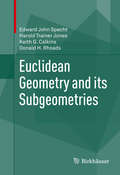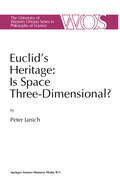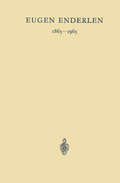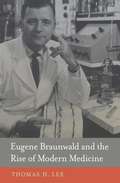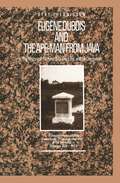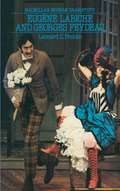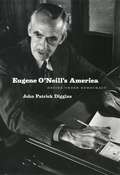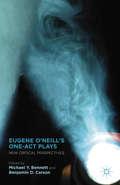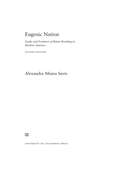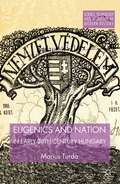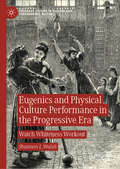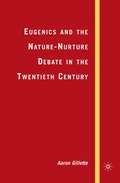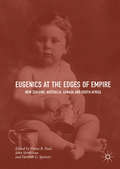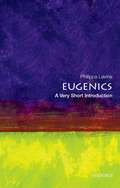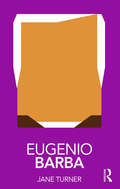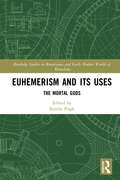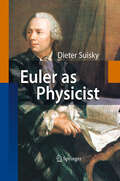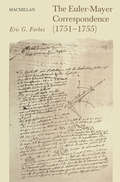- Table View
- List View
Euclidean Geometry and its Subgeometries
by Edward John Specht Harold Trainer Jones Keith G. Calkins Donald H. RhoadsIn this monograph, the authors present a modern development of Euclidean geometry from independent axioms, using up-to-date language and providing detailed proofs. The axioms for incidence, betweenness, and plane separation are close to those of Hilbert. This is the only axiomatic treatment of Euclidean geometry that uses axioms not involving metric notions and that explores congruence and isometries by means of reflection mappings. The authors present thirteen axioms in sequence, proving as many theorems as possible at each stage and, in the process, building up subgeometries, most notably the Pasch and neutral geometries. Standard topics such as the congruence theorems for triangles, embedding the real numbers in a line, and coordinatization of the plane are included, as well as theorems of Pythagoras, Desargues, Pappas, Menelaus, and Ceva. The final chapter covers consistency and independence of axioms, as well as independence of definition properties. There are over 300 exercises; solutions to many of these, including all that are needed for this development, are available online at the homepage for the book at www.springer.com. Supplementary material is available online covering construction of complex numbers, arc length, the circular functions, angle measure, and the polygonal form of the Jordan Curve theorem. Euclidean Geometry and Its Subgeometries is intended for advanced students and mature mathematicians, but the proofs are thoroughly worked out to make it accessible to undergraduate students as well. It can be regarded as a completion, updating, and expansion of Hilbert's work, filling a gap in the existing literature.
Euclid's Heritage. Is Space Three-Dimensional? (The Western Ontario Series in Philosophy of Science #52)
by P. JanichWe live in a space, we get about in it. We also quantify it, we think of it as having dimensions. Ever since Euclid's ancient geometry, we have thought of bodies occupying parts of this space (including our own bodies), the space of our practical orientations (our 'moving abouts'), as having three dimensions. Bodies have volume specified by measures of length, breadth and height. But how do we know that the space we live in has just these three dimensions? It is theoreti cally possible that some spaces might exist that are not correctly described by Euclidean geometry. After all, there are the non Euclidian geometries, descriptions of spaces not conforming to the axioms and theorems of Euclid's geometry. As one might expect, there is a history of philosophers' attempts to 'prove' that space is three-dimensional. The present volume surveys these attempts from Aristotle, through Leibniz and Kant, to more recent philosophy. As you will learn, the historical theories are rife with terminology, with language, already tainted by the as sumed, but by no means obvious, clarity of terms like 'dimension', 'line', 'point' and others. Prior to that language there are actions, ways of getting around in the world, building things, being interested in things, in the more specific case of dimensionality, cutting things. It is to these actions that we must eventually appeal if we are to understand how science is grounded.
Eugen Enderlen 1863–1963
by W. Wachsmuth R. Nissen L. Zukschwerdt W. LutzeyerSeit altersher besteht in der Chirurgie zwischen Meister und Schüler eine besonders enge Beziehung. Dies mag noch aus der Zeit stammen, da die Chirurgie ein Handwerk war und dadurch begründet sein, daß Meister und Gesellen in der operativen Medizin nicht nur eine geistige Gemeinschaft bilden, sondern daß sie durch das gemeinsame Band der inneren Spannung, durch die gemeinsame Erfassung und überwindung unmittel barer Gefahrenmomente, ja allein schon durch die gemeinsame physische Leistung mehr aufeinander angewiesen und zusam mengefügt sind, als dies in den anderen Fächern der Medizin der Fall ist. So ist auch der Begriff der chirurg. Schule stark ausgeprägt und es entspricht besonderer chirurgischer Tradition, der Meister zu gedenken und sie zu ehren. Am 21. Januar 1963 fand aus Anlaß des 100. Geburts tages von Eu GEN END ERLEN weiland o. Professor der Chirurgie an den Universitäten Basel, Würzburg und Heidelberg Geh. Hofrat ein akademischer Festakt statt, zu dem über 150 deutsche und ausländische Chirurgen sich versammelt hatten. Er wurde im Gartenpavillon, dem alten Theatrum Anatomicum des Julius spitals abgehalten, einem akademisch traditions reichen Raume. Die Ehrung galt einem Meister der Chirurgie, einem bedeuten den Forscher und Kliniker und einem großen Arzte, dessen Wirken und Persönlichkeit noch unvergessen ist.
Eugene Braunwald and the Rise of Modern Medicine
by Thomas H. LeeMuch of the improved survival rate from heart attack can be traced to Eugene Braunwald's work. He proved that myocardial infarction was an hours-long dynamic process which could be altered by treatment. Thomas H. Lee tells the life story of a physician whose activist approach transformed not just cardiology but the culture of American medicine.
Eugene Braunwald and the Rise of Modern Medicine
by Thomas H. LeeMuch of the improved survival rate from heart attack can be traced to Eugene Braunwald's work. He proved that myocardial infarction was an hours-long dynamic process which could be altered by treatment. Thomas H. Lee tells the life story of a physician whose activist approach transformed not just cardiology but the culture of American medicine.
Eugène Dubois and the Ape-Man from Java: The History of the First ‘Missing Link’ and Its Discoverer
by L.T. TheunissenAlthough the name Pithecanthropus is now seldom used, there are few who study the origin of our species who will fail to recognise the historical place of the usage and its association with Eugene Dubois. During the last thirty or forty years, Australopithecus and its African context has tended to draw attention from the early work on our origins in Java. It is now increasingly common to hear the term 'pithecanthropine' used only to indicate the Asian or Far Eastern examples of Homo erectus which, although probably derived from African ancestry, have some features that in the opinion of some experts may justify their being considered distinctive. This discussion is not within the pages that follow which deal extensively with the work of Eugene Dubois. He was an extraordinary man who did as much as any person since to put the great antiquity of our ancestors firmly in the public domain. Dubois became involved with the study of human origins from a medical and anatomical background as have many since. The jealousies and professional pressures that we think of as a phenomenon of the post-war years were clearly a major factor in deciding the future of his career.
Eugene O'Neill's America: Desire Under Democracy (Phoenix Poets Ser.)
by John Patrick DigginsIn the face of seemingly relentless American optimism, Eugene O’Neill's plays reveal an America many would like to ignore, a place of seething resentments, aching desires, and family tragedy, where failure and disappointment are the norm and the American dream a chimera. Though derided by critics during his lifetime, his works resonated with audiences, won him the Nobel Prize and four Pulitzer, and continue to grip theatergoers today. Now noted historian John Patrick Diggins offers a masterly biography that both traces O’Neill’s tumultuous life and explains the forceful ideas that form the heart of his unflinching works. Diggins paints a richly detailed portrait of the playwright’s life, from his Irish roots and his early years at sea to his relationships with his troubled mother and brother. Here we see O’Neill as a young Greenwich Village radical, a ravenous autodidact who attempted to understand the disjunction between the sunny public face of American life and the rage that he knew was simmering beneath. According to Diggins, O’Neill mined this disjunction like no other American writer. His characters burn with longing for an idealized future composed of equal parts material success and individual freedom, but repeatedly they fall back to earth, pulled by the tendrils of family and the insatiability of desire. Drawing on thinkers from Emerson to Nietzsche, O’Neill viewed this endlessly frustrated desire as the problematic core of American democracy, simultaneously driving and undermining American ideals of progress, success, and individual freedom. Melding a penetrating assessment of O’Neill’s works and thought with a sensitive re-creation of his life, Eugene O’Neill’s America offers a striking new view of America’s greatest playwright—and a new picture of American democracy itself.
Eugene O'Neill's America: Desire Under Democracy
by John Patrick DigginsIn the face of seemingly relentless American optimism, Eugene O’Neill's plays reveal an America many would like to ignore, a place of seething resentments, aching desires, and family tragedy, where failure and disappointment are the norm and the American dream a chimera. Though derided by critics during his lifetime, his works resonated with audiences, won him the Nobel Prize and four Pulitzer, and continue to grip theatergoers today. Now noted historian John Patrick Diggins offers a masterly biography that both traces O’Neill’s tumultuous life and explains the forceful ideas that form the heart of his unflinching works. Diggins paints a richly detailed portrait of the playwright’s life, from his Irish roots and his early years at sea to his relationships with his troubled mother and brother. Here we see O’Neill as a young Greenwich Village radical, a ravenous autodidact who attempted to understand the disjunction between the sunny public face of American life and the rage that he knew was simmering beneath. According to Diggins, O’Neill mined this disjunction like no other American writer. His characters burn with longing for an idealized future composed of equal parts material success and individual freedom, but repeatedly they fall back to earth, pulled by the tendrils of family and the insatiability of desire. Drawing on thinkers from Emerson to Nietzsche, O’Neill viewed this endlessly frustrated desire as the problematic core of American democracy, simultaneously driving and undermining American ideals of progress, success, and individual freedom. Melding a penetrating assessment of O’Neill’s works and thought with a sensitive re-creation of his life, Eugene O’Neill’s America offers a striking new view of America’s greatest playwright—and a new picture of American democracy itself.
Eugene O’Neill’s One-Act Plays: New Critical Perspectives
by Michael Y. BennettEugene O'Neill, Nobel Laureate in Literature and Pulitzer Prize winner, is widely known for his full length plays. However, his one-act plays are the foundation of his work - both thematically and stylistically, they telescope his later plays. This collection aims to fill the gap by examining these texts, during what can be considered O'Neill's formative writing years, and the foundational period of American drama. A wide-ranging investigation into O'Neill's one-acts, the contributors shed light on a less-explored part of his career and assist scholars in understanding O'Neill's entire oeuvre.
Eugenic Nation: Faults And Frontiers Of Better Breeding In Modern America (American Crossroads Ser. (PDF))
by Alexandra Minna SternWith an emphasis on the American West, this work explores the long and unsettled history of eugenics in the United States. This expanded second edition includes shocking details demonstrating that eugenics continues to inform institutional and reproductive injustice. It draws on recently uncovered historical records to reveal patterns of racial bias in California's sterilisation program and documents compelling individual experiences. With the addition of radically new and relevant research, this edition connects the eugenic past to the genomic present with attention to the ethical and social implications of emerging genetic technologies.
Eugenic Nation: Faults And Frontiers Of Better Breeding In Modern America (pdf) (American Crossroads Ser.)
by Alexandra Minna SternWith an emphasis on the American West, Eugenic Nation explores the long and unsettled history of eugenics in the United States. This expanded second edition includes shocking details demonstrating that eugenics continues to inform institutional and reproductive injustice. Alexandra Minna Stern draws on recently uncovered historical records to reveal patterns of racial bias in California’s sterilization program and documents compelling individual experiences. With the addition of radically new and relevant research, this edition connects the eugenic past to the genomic present with attention to the ethical and social implications of emerging genetic technologies.
Eugenics and Nation in Early 20th Century Hungary (Science, Technology and Medicine in Modern History)
by M. TurdaIn 1900 Hungary was a regional power in Europe with imperial pretensions; by 1919 it was crippled by profound territorial, social and national transformations. This book chronicles the development of eugenic thinking in early twentieth-century Hungary, examining how eugenics was an integral part of this dynamic historical transformation.
Eugenics and Physical Culture Performance in the Progressive Era: Watch Whiteness Workout (Palgrave Studies in Theatre and Performance History)
by Shannon L. WalshThis book strives to unmask the racial inequity at the root of the emergence of modern physical culture systems in the US Progressive Era (1890s–1920s). This book focuses on physical culture – systematic, non-competitive exercise performed under the direction of an expert – because tracing how people practiced physical culture in the Progressive Era, especially middle- and upper-class white women, reveals how modes of popular performance, institutional regulation, and ideologies of individualism and motherhood combined to sublimate whiteness beneath the veneer of liberal progressivism and reform. The sites in this book give the fullest picture of the different strata of physical culture for white women during that time and demonstrate the unracialization of whiteness through physical culture practices. By illuminating the ways in which whiteness in the US became a default identity category absorbed into the “universal” ideals of culture, arts, and sciences, the author shows how physical culture circulated as a popular performance form with its own conventions, audience, and promised profitability. Finally, the chapters reveal troubling connections between the daily habits physical culturists promoted and the eugenics movement’s drive towards more reproductively efficient white bodies. By examining these written, visual, and embodied texts, the author insists on a closer scrutiny of the implicit whiteness of physical culture and forwards it as a crucial site of analysis for performance scholars interested in how corporeality is marshaled by and able to contest local and global systems of power.
Eugenics and the Nature-Nurture Debate in the Twentieth Century (Palgrave Studies in the History of Science and Technology)
by A. GilletteGillette shows that the sciences of sociobiology and evolutionary psychology were undergoing rapid development in the early Twentieth century. However, many of the early researchers in these sciences were also eugenicists. With the rise of behaviourism and the reaction against eugenics in the 1930s, any scientific claims that behaviour might be influenced by heredity were suppressed for ideological reasons.
Eugenics at the Edges of Empire: New Zealand, Australia, Canada and South Africa
by Diane B. Paul John Stenhouse Hamish G. SpencerThis volume explores the history of eugenics in four Dominions of the British Empire: New Zealand, Australia, Canada, and South Africa. These self-governing colonies reshaped ideas absorbed from the metropole in accord with local conditions and ideals. Compared to Britain (and the US, Germany, and Scandinavia), their orientation was generally less hereditarian and more populist and agrarian. It also reflected the view that these young and enterprising societies could potentially show Britain the way — if they were protected from internal and external threat. This volume contributes to the increasingly comparative and international literature on the history of eugenics and to several ongoing historiographic debates, especially around issues of race. As white-settler societies, questions related to racial mixing and purity were inescapable, and a notable contribution of this volume is its attention to Indigenous populations, both as targets and on occasion agents of eugenic ideology.
Eugenics at the Edges of Empire: New Zealand, Australia, Canada and South Africa
by Diane B. Paul John Stenhouse Hamish G. SpencerThis volume explores the history of eugenics in four Dominions of the British Empire: New Zealand, Australia, Canada, and South Africa. These self-governing colonies reshaped ideas absorbed from the metropole in accord with local conditions and ideals. Compared to Britain (and the US, Germany, and Scandinavia), their orientation was generally less hereditarian and more populist and agrarian. It also reflected the view that these young and enterprising societies could potentially show Britain the way — if they were protected from internal and external threat. This volume contributes to the increasingly comparative and international literature on the history of eugenics and to several ongoing historiographic debates, especially around issues of race. As white-settler societies, questions related to racial mixing and purity were inescapable, and a notable contribution of this volume is its attention to Indigenous populations, both as targets and on occasion agents of eugenic ideology.
Eugenics: A Very Short Introduction (Very Short Introductions)
by Philippa LevineIn 1883, Francis Galton, a cousin of Charles Darwin, coined the word "eugenics" to express his dream of perfecting the human race by applying the laws of genetic heredity. Adapting Darwin's theory of evolution to human society, eugenics soon became a powerful, international movement, committed to using the principles of heredity and statistics to encourage healthy and discourage unhealthy reproduction. Early in the twentieth century and across the world, doctors, social reformers, and politicians turned to the new science of eugenics as a means to improve and strengthen their populations. Eugenics advocates claimed their methods would result in healthier, fitter babies and would dramatically limit human suffering. The reality was a different story. In the name of scientific progress and of human improvement, eugenicists targeted the weak and the sick, triggering coercive legislation on issues as disparate as race, gender, immigration, euthanasia, abortion, sterilization, intelligence, mental illness, and disease control. Nationalists eagerly embraced eugenics as a means to legitimize their countries' superiority and racialized assumptions, and the Nazis notoriously used eugenics to shape their "final solution." In this lucid volume, Philippa Levine tackles the intricate and controversial history of eugenics, masterfully synthesizing the enormous range of policies and experiments carried out in the name of eugenics around the world throughout the twentieth century. She questions the widespread belief that eugenics disappeared after World War II and evaluates the impact of eugenics on current reproductive and genetic sciences. Charting the development of such controversial practices as artificial insemination, sperm donation, and population control, this book offers a powerful, extraordinarily timely reflection on the frequent interplay between genetics and ethics. Eugenics may no longer be a household word, but we feel its effects even today.
Eugenics: A Very Short Introduction (Very Short Introductions)
by Philippa LevineIn 1883, Francis Galton, a cousin of Charles Darwin, coined the word "eugenics" to express his dream of perfecting the human race by applying the laws of genetic heredity. Adapting Darwin's theory of evolution to human society, eugenics soon became a powerful, international movement, committed to using the principles of heredity and statistics to encourage healthy and discourage unhealthy reproduction. Early in the twentieth century and across the world, doctors, social reformers, and politicians turned to the new science of eugenics as a means to improve and strengthen their populations. Eugenics advocates claimed their methods would result in healthier, fitter babies and would dramatically limit human suffering. The reality was a different story. In the name of scientific progress and of human improvement, eugenicists targeted the weak and the sick, triggering coercive legislation on issues as disparate as race, gender, immigration, euthanasia, abortion, sterilization, intelligence, mental illness, and disease control. Nationalists eagerly embraced eugenics as a means to legitimize their countries' superiority and racialized assumptions, and the Nazis notoriously used eugenics to shape their "final solution." In this lucid volume, Philippa Levine tackles the intricate and controversial history of eugenics, masterfully synthesizing the enormous range of policies and experiments carried out in the name of eugenics around the world throughout the twentieth century. She questions the widespread belief that eugenics disappeared after World War II and evaluates the impact of eugenics on current reproductive and genetic sciences. Charting the development of such controversial practices as artificial insemination, sperm donation, and population control, this book offers a powerful, extraordinarily timely reflection on the frequent interplay between genetics and ethics. Eugenics may no longer be a household word, but we feel its effects even today.
Eugenio Barba (Routledge Performance Practitioners)
by Jane TurnerEugenio Barba is recognized as one of the most important theatre practitioners working today. Along with the company he founded over fifty years ago, the world-acclaimed Odin Teatret, he continues to produce extraordinary theatre performances that tour the world, and his International School of Theatre Anthropology has greatly developed research into the craft of the actor. Now revised and updated, this volume reveals the background to and work of a major influence on twentieth- and twenty-first century performance. Eugenio Barba is the first book to combine: an overview of Barba’s work and that of his company, Odin Teatret exploration of his writings and ideas on theatre anthropology, and his unique contribution to contemporary performance research in-depth analysis of the 2000 production of Ego Faust, performed at the International School of Theatre Anthropology a practical guide to training exercises developed by Barba and the actors in the company. As a first step towards critical understanding, and as an initial exploration before going on to further, primary research, Routledge Performance Practitioners offer unbeatable value for today’s student.
Eugenio Barba (Routledge Performance Practitioners)
by Jane TurnerEugenio Barba is recognized as one of the most important theatre practitioners working today. Along with the company he founded over fifty years ago, the world-acclaimed Odin Teatret, he continues to produce extraordinary theatre performances that tour the world, and his International School of Theatre Anthropology has greatly developed research into the craft of the actor. Now revised and updated, this volume reveals the background to and work of a major influence on twentieth- and twenty-first century performance. Eugenio Barba is the first book to combine: an overview of Barba’s work and that of his company, Odin Teatret exploration of his writings and ideas on theatre anthropology, and his unique contribution to contemporary performance research in-depth analysis of the 2000 production of Ego Faust, performed at the International School of Theatre Anthropology a practical guide to training exercises developed by Barba and the actors in the company. As a first step towards critical understanding, and as an initial exploration before going on to further, primary research, Routledge Performance Practitioners offer unbeatable value for today’s student.
Euhemerism and Its Uses: The Mortal Gods (Routledge Studies in Renaissance and Early Modern Worlds of Knowledge)
by Syrithe PughEuhemerism and Its Uses offers the first interdisciplinary, focussed, and all-round view of the long history of an important but understudied phenomenon in European intellectual and cultural history. Euhemerism – the claim that the Greek gods were historically mortal men and women – originated in the early third century BCE, in an enigmatic and now fragmentary text by the otherwise unknown author Euhemeros. This work, the Sacred Inscription, has been read variously as a theory of religion, an atheist’s manifesto, as justifying or satirizing ruler-worship, as a fantasy travel-narrative, and as an early ‘utopia’. Influencing Hellenistic and Roman literature and religious and political thought, and appropriated by early Christians to debunk polytheism while simultaneously justifying the continued study of classical literature, euhemerism was widespread in the middle ages and Renaissance, and its reverberations continue to be felt in modern myth-theory. Yet, though frequently invoked as a powerful and pervasive tradition across several disciplines, it is still under-examined and poorly understood. Filling an important gap in the history of ideas, this volume will appeal to scholars and students of classical reception, mediaeval and Renaissance literature, historiography, and theories of myth and religion.
Euhemerism and Its Uses: The Mortal Gods (Routledge Studies in Renaissance and Early Modern Worlds of Knowledge)
by Syrithe PughEuhemerism and Its Uses offers the first interdisciplinary, focussed, and all-round view of the long history of an important but understudied phenomenon in European intellectual and cultural history. Euhemerism – the claim that the Greek gods were historically mortal men and women – originated in the early third century BCE, in an enigmatic and now fragmentary text by the otherwise unknown author Euhemeros. This work, the Sacred Inscription, has been read variously as a theory of religion, an atheist’s manifesto, as justifying or satirizing ruler-worship, as a fantasy travel-narrative, and as an early ‘utopia’. Influencing Hellenistic and Roman literature and religious and political thought, and appropriated by early Christians to debunk polytheism while simultaneously justifying the continued study of classical literature, euhemerism was widespread in the middle ages and Renaissance, and its reverberations continue to be felt in modern myth-theory. Yet, though frequently invoked as a powerful and pervasive tradition across several disciplines, it is still under-examined and poorly understood. Filling an important gap in the history of ideas, this volume will appeal to scholars and students of classical reception, mediaeval and Renaissance literature, historiography, and theories of myth and religion.
Euler as Physicist
by Dieter SuiskyThe subject of the book is the development of physics in the 18th century centered upon the fundamental contributions of Leonhard Euler to physics and mathematics. This is the first book devoted to Euler as a physicist. Classical mechanics are reconstructed in terms of the program initiated by Euler in 1736 and its completion over the following decades until 1760. The book examines how Euler coordinated his progress in mathematics with his progress in physics.
